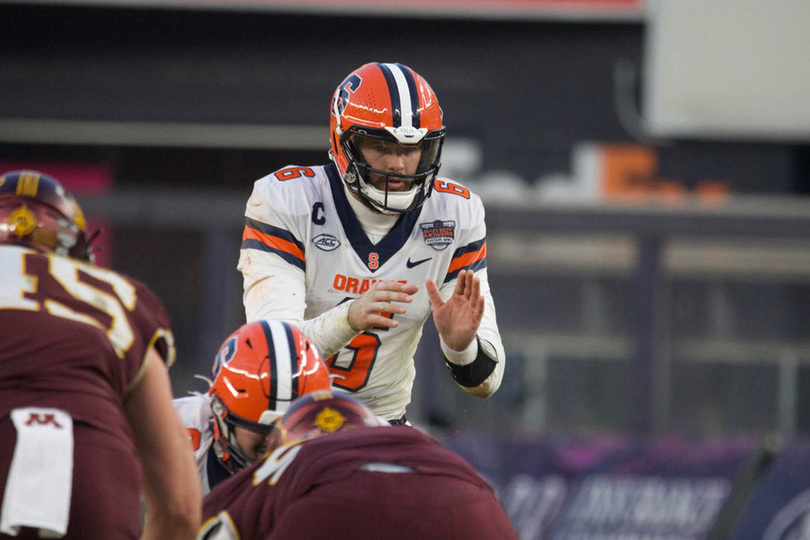A pick-6, 75-yard kickoff return highlight Syracuse’s mistakes in Pinstripe Bowl defeat

Shrader's pick-6 triggered a late deficit for the Orange, and Dino Babers said that special teams issues and penalties that persisted throughout the season hindered Syracuse in the Pinstripe Bowl. Jacob Halsema | Staff Photographer
Get the latest Syracuse news delivered right to your inbox. Subscribe to our sports newsletter here.
Garrett Shrader looked toward his right as Oronde Gadsden II executed a simple out route. Syracuse was on fire after LeQuint Allen’s two explosive runs had set it up in Minnesota territory. Down 14-10 midway through the third quarter, the Orange — even with a field goal to cap off the drive — could feel more in control than in the first half, down 14-0. Shrader stood alone in the backfield with three receivers to his right and two to his left. The snap was seamless as Shrader rocked into a throw that he had made three times already Thursday afternoon.
But Shrader was struggling at points during the first half — and throughout the game. He underthrew Gadsden, like he’d done on at least four other previous throws. Minnesota defensive back Coleman Bryson read the throw perfectly, too — he quickly changed course, jumped the route and bolted 70 yards down the field. The pick-6 ultimately lifted the Golden Gophers over SU, and an explosive kick return a few possessions later would seal the game for Minnesota.
Syracuse made lots of mistakes this season. Dating back to its week one win over Louisville, a surprising victory that helped catalyze a historic 6-0 start, the Orange still set the program record for the most penalties in a game. There have been punting and kicking woes, poor return team packages and Shrader’s costly interceptions that cemented losses. Against Minnesota (9-4, 5-4 Big 10), everything that normally goes wrong for Syracuse (7-6, 4-4 Atlantic Coast) went wrong in a 28-20 Pinstripe Bowl loss.
“The thing that we need to improve on — there’s no doubt about it — is our special teams and our penalties,” head coach Dino Babers said. “Both of those showed up in this game, showed up in the first game, showed up in the last game.”
After the interception, Syracuse drove down the field and executed a 13-play drive that set up Andre Szymt’s connection on a 38-yard field goal. The Orange were down 21-13 with 1:38 to go in the third quarter, a tall task given the inconsistent offense still reeling from the pick-6, but a manageable deficit with a little over a quarter left to play. Allen, who got the ball seven times on the drive, was starting to get going and the Orange, who didn’t commit a penalty on the drive, looked to finish out strong after a poor start.
Babers paused before finishing his answer to a question about an area of change he thinks Syracuse needs to focus on heading into next season. Could it be penalties — like the holding call that stalled out Syracuse’s drive late in the fourth quarter? Was it special teams or the punting unit that averaged below 30 yards per punt against Minnesota? Sure, he said.
Just as penalties and special teams had been an issue throughout a tumultuous 1-6 skid to end the year, they prevented Syracuse from winning an eighth game.
The ensuing kickoff from Brady Denberg hardly reached the 10-yard line. Babers said the Orange need longer kickoffs than what they had on Thursday. Quentin Redding grabbed the kickoff and swung out to the right numbers, running straight as a group of Minnesota players sprinted left. Then, Redding faked a pitch to Le’Meke Brockington, one of the players sprinting left with blockers in front of him. At least three of Syracuse’s blockers bit on the fake and followed Brockington, creating a huge hole for Redding to burst through. The receiver made it all the way to Syracuse’s 25-yard line before Denberg tackled him.
The design, Minnesota head coach P.J. Fleck said, was something that special teams coach Rob Wenger had been working on for the last four weeks. He’s a coordinator that wants to use fakes and has the team practice them from the beginning of August training camp. Twenty-eight days of prepping that play paid off when Minnesota took just three plays to get back into the end zone to cement a 28-13 lead — one that would prove to be too much for the Orange to overcome despite a late push.
“It’s a great call by Wenger. It’s a great design, and it was the right moment for it,” Fleck said.
Minnesota didn’t shut down Syracuse’s prolific offense. The Orange still put up over 400 total yards, 330 of which came from passing, but they beat them with what Fleck called “prototypical football guys,” relying on strong players that can make stops and crucial plays.
Guys like Mariano Sori-Marin did just enough, halting Syracuse’s drives between midfield and the Golden Gophers 30-yard line. While Minnesota was capitalizing on Syracuse’s mistakes — the blown passes, the poorly-defended kickoffs — the Golden Gophers were holding the Orange to punts or field goals.
Allen admitted that there were plenty of reasons to believe the offense needs to improve, and Babers added that some of the receivers need to take large steps before the start of 2023. Offensive coordinator Jason Beck and having Shrader, Gadsden and Damien Alford back provide some sense of stability for the offense. The defense and offensive line are in transition, but the special teams unit, one that’s led by veteran coach Bob Ligashesky, is in flux.
“I’m positive about a lot of things, but there are certain things that it’s hard to be really positive about,” Babers said.





